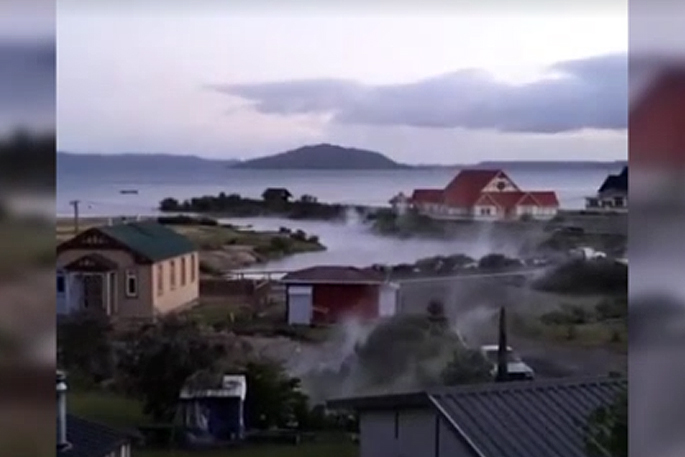A hydrothermal eruption in Lake Rotorua earlier this morning sent a household of lakeside residents to higher ground.
Ohinemutu resident Lani Kereopa says she was awakened by several loud thuds. At 4.30am she didn't think it was likely to be roadworks or fireworks.
When another one happened she stood up and looked out the window.
'Nothing much, looked different even though it was dark,” says Lani on a video she posted to her Facebook page.
'And then another one happened and I saw water spraying up out of the lake.”
The eruption was near the mouth of the Ruapeka Stream, and it was higher than the Pohutu geyser, says Lani.
Water from Pohutu geyser sometimes reaches 30 metres. She ran and roused the household.
They got in the car and drove up to the lake house carpark where they sat for an hour waiting to see if anything else was going to happen.
Volcanologist at GNS Wairakei, Brad Scott says it's been 15 years since the previous Rotorua hydrothermal eruption, which was in Kuirau Park on the other side of the hospital, but part of the same geothermal system which extends from Whakarewarewa through town and into the lake.
Today's eruption was in the shallow part of the lake, but scientists know of large scale craters and hydrothermal vents on the lake floor.
Hydrothermal eruptions used to take place several times a year, before the city's hydrothermal exploitation was drastically reduced.
'It's the draw-down. When pull the geothermal system down you create more steam and that leads to hydrothermal eruptions,” says Brad.
The analogy is boiling water in an electric jug. If the water level in the jug is three quarters or more full, there is not much steam in the top of it. But if it is only a third full then most of the volume of the jug is steam.
'You get a lot more steam going out of the jug, that's basically how a geothermal system works.
'The main point is they are not unknown. They have happened historically. In this area they are not unusual. The part that is unusual is that it's been 15 years.”
The other issue is the connection or not, with the Kaikoura earthquake.
'It's very difficult to connect the dots, like to the Kaikoura earthquake, the East Cape earthquake or any other large scale phenomena like that,” says Brad.
'You do get observations of phenomena like this occurring as a coincidence at the same time. It's very difficult to think of a physical process and connect the dots.
'These occurrences are real and have occurred at this time. Just how you make the connection with something like the Kaikoura earthquake is really difficult.
'You can't eliminate that as being the source or potentially being related, but you sure as hell can't connect the dots easily to say it was.”
Today's hydrothermal eruption may make it less likely there will be another one soon because it may have depressurized the system, says Brad.
'But that's not always the case.”



0 comments
Leave a Comment
You must be logged in to make a comment.